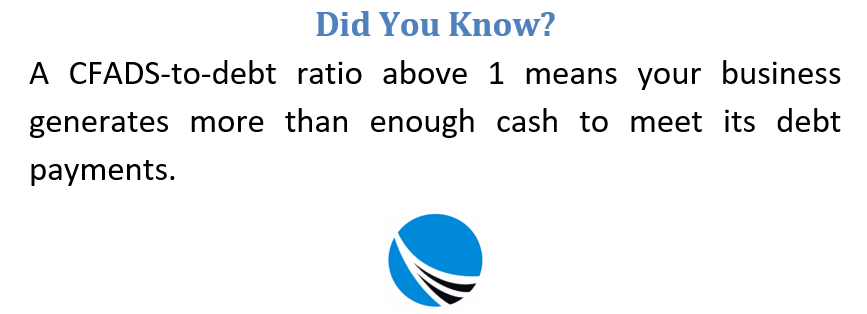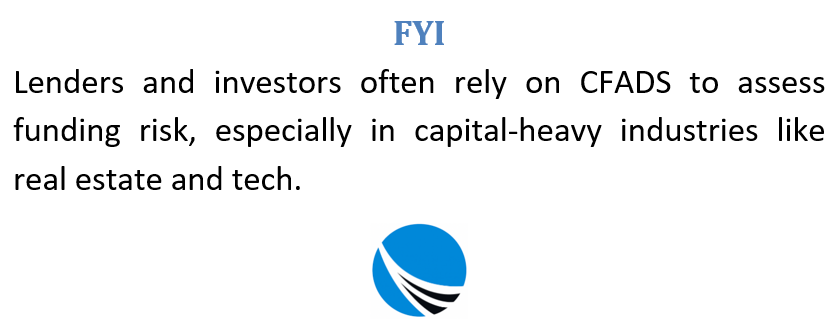When businesses take on debt to fund expansion or maintain operations, their ability to repay those obligations becomes a primary concern for lenders. A widely adopted tool to evaluate this capability is Cash Flow Available for Debt Servicing (CFADS). This financial metric offers a detailed snapshot of the cash that remains after all essential business expenses are deducted, making it instrumental in assessing whether a company can meet its debt payments.

Defining CFADS in Business Finance
CFADS, or Cash Flow Available for Debt Servicing, is the amount of cash a company has left after accounting for its operating expenses, taxes, capital investments, and working capital changes. This remaining cash is the actual pool of funds a company can use to meet its debt repayments—principal and interest. It provides a more realistic financial health indicator than traditional profit metrics because it reflects actual cash movement rather than accounting-based earnings.
CFADS is also referred to as CADS (Cash Available for Debt Service) and is especially useful for industries that rely heavily on debt financing. Its comprehensive approach makes it a favorite among banks and investment analysts seeking clarity on repayment potential.
CFADS Compared to EBITDA
While CFADS is growing in importance, many businesses still rely on EBITDA—Earnings Before Interest, Taxes, Depreciation, and Amortization—as a performance metric. Introduced in the 1980s, EBITDA became popular for providing a standard method to assess operating performance without the influence of financing decisions or non-cash expenses.
However, EBITDA excludes several vital components. It ignores taxes, capital expenditures, and changes in working capital—factors that significantly affect a company’s ability to service debt. Because of this, EBITDA can sometimes provide a misleading picture, suggesting strong performance even when cash reserves are insufficient.
In contrast, CFADS offers a clearer, more detailed view by including those excluded elements. It evaluates not just how much profit a company generates, but how much of that profit is actually available to pay creditors.
Breaking Down the CFADS Formula
There are different methods for calculating CFADS depending on the financial data available and the industry context. The two most common approaches are either starting from EBITDA or from cash receipts. Both routes aim to capture a company’s net available cash for debt service.

Method One: EBITDA-Based Calculation
This method begins with EBITDA and then makes a series of deductions:
- Adjust for fluctuations in working capital (such as increases in receivables or inventory)
- Subtract capital expenditures, which are investments in long-term assets
- Account for any equity injections or repayments of previous funding
- Deduct taxes paid to government authorities
The end result is the cash flow specifically earmarked for meeting debt repayments.
Method Two: Cash Receipts Approach
The second method focuses on actual cash flows:
- Begin with total receipts from customers
- Subtract operational outflows, including payments to employees and suppliers
- Deduct royalties and other periodic payments
- Subtract capital expenditures made during the reporting period
- Deduct taxes
This version emphasizes real-time inflows and outflows, making it particularly useful in cash-intensive industries.
Why CFADS Matters to Lenders and Investors
Lenders are fundamentally concerned with repayment capability. A high EBITDA might signal profitability, but if those profits are tied up in taxes, new equipment, or rising inventory costs, they may never reach the bank. That’s why CFADS is considered more reliable when evaluating creditworthiness.
CFADS serves as a key ratio in loan agreements and financial covenants. When used in combination with a debt service coverage ratio (DSCR), it provides direct insight into a company’s financial resilience. A CFADS-to-debt ratio greater than one means the company generates more than enough cash to meet its obligations. A ratio below one raises red flags and often leads to denied funding or stricter loan terms.
CFADS in Debt-Heavy Industries
Industries that depend on leveraged financing—like real estate, manufacturing, energy, or hospitality—stand to benefit most from CFADS analysis. These businesses often face large capital requirements and recurring debt obligations, making cash flow predictability crucial.
For instance, a property developer with irregular income from project completions may use CFADS to demonstrate its ability to cover loan payments during construction. Similarly, a tech company investing in infrastructure or product development might rely on CFADS projections to attract venture debt or structured finance deals.
Incorporating CFADS into Business Strategy
Beyond its usefulness in securing loans, CFADS can play an essential role in strategic decision-making. When planning annual budgets, business leaders can use projected CFADS figures to determine realistic debt thresholds, avoiding over-leveraging. It also helps finance teams assess whether dividends or reinvestments will compromise debt service ability.
Including CFADS in management dashboards allows companies to track their solvency on a rolling basis. Rather than being surprised by liquidity shortages or missed payments, businesses can use trends in CFADS to proactively restructure debt, delay capital spending, or negotiate new financing terms.
CFADS as a Communication Tool
Reporting CFADS to investors and lenders demonstrates a company’s commitment to financial transparency. Investors appreciate that CFADS shows the genuine surplus available after paying for essentials, making it a more trustworthy indicator than gross profit or EBITDA.
Moreover, regular disclosure of CFADS figures during earnings calls, investor updates, or board meetings enhances confidence. For privately held businesses or startups, this metric can serve as a compelling argument during funding rounds, illustrating stability and fiscal discipline.
CFADS and Dividend Policy
Businesses with shareholders often face pressure to distribute earnings through dividends. However, excessive dividend payouts can jeopardize debt repayment capabilities. CFADS provides a safeguard by helping managers calculate how much can be paid out without risking financial health.
By using CFADS as a benchmark, companies can establish dividend policies that reward investors without undermining long-term viability. It also allows boards to defend conservative payout ratios by presenting data-driven reasoning.
Improving Your CFADS Ratio
Improving CFADS typically involves better cash management. This might include tightening credit terms with customers, renegotiating payment timelines with suppliers, or reducing unnecessary operating costs. Managing capital expenditure cycles can also help, ensuring that large asset purchases align with periods of high revenue.
Tax planning plays a role as well. By optimizing deductions or deferring tax liabilities legally, businesses can boost their net available cash. All of these adjustments improve the CFADS ratio, strengthening the company’s appeal to lenders.
Practical Example
Consider a mid-sized logistics firm with steady earnings but rising debt obligations. By calculating CFADS, the company finds that after deducting taxes, equipment upgrades, and rising payroll costs, only a fraction of its earnings remains to cover debt. This revelation prompts management to delay a new warehouse expansion and instead focus on consolidating operations.
They also renegotiate supplier contracts and adjust their billing cycle to speed up receivables. As a result, their CFADS improves significantly within two quarters, allowing them to approach lenders with renewed confidence for future financing.
When to Use CFADS Over Other Metrics
While many financial ratios serve different purposes—such as ROI, net profit margin, or free cash flow—CFADS stands out for debt-specific scenarios. Use it when:
- Preparing to apply for loans or credit facilities
- Drafting covenants for financial agreements
- Reviewing company solvency ahead of dividend payments
- Making long-term capital investment decisions
- Reporting to institutional investors or credit rating agencies
Final Take Away
Cash Flow Available for Debt Servicing (CFADS) is more than just another financial acronym—it’s a strategic lens through which businesses can evaluate their true financial strength. Unlike superficial indicators that overlook major cash demands, CFADS gives a transparent view of what’s genuinely left to repay obligations.
Its importance spans industries and company sizes, offering both internal insights and external credibility. For businesses seeking sustainable growth through responsible financing, mastering CFADS is not just an option—it’s a necessity.

Frequently Asked Questions about CFADS
How Does CFADS Differ from EBITDA?
Unlike EBITDA, CFADS includes taxes, capital expenditures, and working capital changes, offering a clearer picture of cash available for debt payments.
Why Is CFADS Important for Lenders?
Lenders prefer CFADS because it directly reflects a company’s ability to meet debt obligations, reducing the risk of loan defaults.
How Is CFADS Calculated?
CFADS is typically calculated by adjusting EBITDA or customer receipts for taxes, capital expenses, and working capital movements.
When Should Businesses Use CFADS?
Use CFADS when applying for loans, setting budgets, planning dividends, or reporting to investors to show financial stability.
